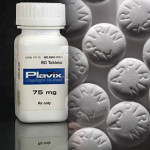 After a heart stent placement, it is common practice for the patient to take a drug such as Plavix for the following year, but new research shows it might be safe to stop the double anti-platelet therapy, consisting of aspirin and prescription blood thinners, sooner rather than later.
After a heart stent placement, it is common practice for the patient to take a drug such as Plavix for the following year, but new research shows it might be safe to stop the double anti-platelet therapy, consisting of aspirin and prescription blood thinners, sooner rather than later.
Currently Plavix is used after stent placement to reduce the risk of clot formation in the stent (instent thrombosis), which could result in serious consequences, such as another heart attack. It is believed that the risk of instent thrombosis is highest in the first few months after the stent was placed. Over time endothelial cells grow over the stent, which reduces the risk of instent thrombosis.
But, according to Korean and Spanish researchers, their research indicates that patients who didn’t continue with the therapy after several months were no different than those who were treated for a year.
“The interesting thing is, we went through a period of time so panicked about anti-platelet therapy interruptions and the effect they might have,” said Dr. Kirk Garratt, director of clinical research at Lenox Hill Heart and Vascular Institute of New York City, who was not involved in the studies. “But over the last few years, a series of reports and clinical trials say the same thing — that we probably don’t need to be as worked up about it as we used to be.”
According to the U.S. Centers for Disease Control and Prevention, cardiac stents are mesh tubes that prevent heart arteries from re-closing. They are implanted in more than 500,000 Americans each year. Some stents are coated with slowly released medication to prevent the growth of scar tissue in the artery lining.
Prescription blood thinners used in double anti-platelet therapy, such as clopidogrel (Plavix) and warfarin (Coumadin), are tricky to dose properly and can lead to life-threatening bleeding complications.
The Korean study split more than 2,100 patients, all of whom underwent stent surgery after angina (chest pain) or a heart attack, into groups treated with either three months of double anti-platelet therapy or the standard 12-month course. After a year, just less than 5 percent of both groups had suffered complications such as death, bleeding, heart attack or clotting near the stent.
The Spanish study addressed interruptions in double anti-platelet therapy due to noncompliance, surgery or other medical decisions in a group of 1,600 patients. Most of the 10.6 percent of patients who discontinued the therapy did so temporarily, but this practice didn’t translate into more serious consequences compared to those whose therapy was not interrupted.
“The big takeaway is that neither of these studies fundamentally change the way I think about these therapies for my patients,” Garratt said. “But the Spanish study increases my confidence in the way I’m managing these patients.”
But Dr. Christopher Cove, associate professor of medicine and assistant director of the cardiac catheterization lab at University of Rochester Medical Center in New York, cautioned it would be a mistake to think it’s safe to stop double anti-platelet therapy based on the new research. Larger studies are needed, he added.
“We know that [double anti-platelet therapy] is beneficial as compared to aspirin alone in large groups of patients, and that there’s a high risk of bleeding with it,” Cove said. “What we really need to know is, if we have to stop double anti-platelet therapy, when is the safe time to do that.”
The two studies were published in the Journal of the American College of Cardiology.
